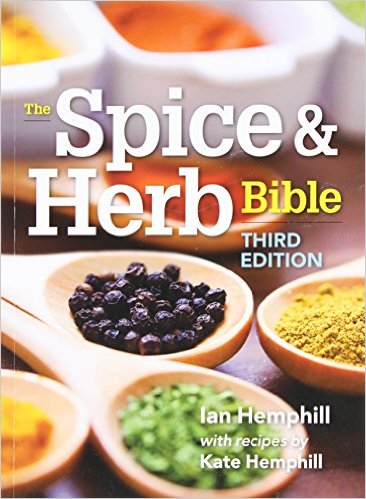 As more and more people become interested in the diverse foods available around the world the need for a knowledge of spices and herbs becomes more important. Ian Hemphill’s book, The Spice and Herb Bible, fills that need in a big way. With over 800 pages the book covers more than ninety spices of global importance giving the reader “the inside story”. It includes information that will interest readers whether they are gourmets or gourmands or just interested in eating well.
As more and more people become interested in the diverse foods available around the world the need for a knowledge of spices and herbs becomes more important. Ian Hemphill’s book, The Spice and Herb Bible, fills that need in a big way. With over 800 pages the book covers more than ninety spices of global importance giving the reader “the inside story”. It includes information that will interest readers whether they are gourmets or gourmands or just interested in eating well.
The first part of the book is short and covers the basics: history, difference between herbs and spices, and buying, storing and using them. The second section is the meat of the book and describes the spices and herbs in detail. Entries includes a color photograph, description, origin and history, information on processing, buying, storage, and use, and a recipe. Also included are common names in a multitude of languages, botanical name and family, flavor group, weight per teaspoon, suggested quantity to be used per pound of other foods, cooking applications, blends, and herbs/spices combinations. The recipes are especially enchanting as they tweek the imagination and make the mouth water. The entries are arranged alphabetically by common name and go from Ajowan (a relative of parsley from India with seeds that taste like thyme) to Zedorary (also from India with a pungent flavor). In between are both exotic and common herbs and spices such as basil, lovage, and anise.
All sorts of interesting information is included. Did you know that nutmeg is produced by female trees and that one male tree can service ten females trees? that borage leaves can be dipped in batter and fried? that asafoetida, the resinous gum from a giant fennel tree, is used with lentils and beans to reduce flatulence? or that the berries of one species of barberry (Berberis vulgaris) give a tangy flavor to foods and makes excellent zereshk polo, a Persian rice and chicken dish.
The third part of the book deals with blending spices. After discussing the the spices found in popular cuisines and the principles of making spice blends, the author provides the recipes for a large variety of blends from the Turkish baharat used with lamb, to za’atar, a middle eastern blend of thyme, sumac, sesame seeds and salt, delicious with bread and potato. Recipes for barbecue blends, numerous curries, taco seasoning, fines herbs, garam masala, bouquet garni, Mexican chili powder and many more are also included.
Hemphill has a long history of experiences with spices. He grew up in Sidney, Australia and worked in the family spice business. After managing a spice company overseas he returned home to Sidney where he opened up his own spice store, Herbie’s Spices. In a section of the book called ‘Travels in the Spice Trade” the authors relates his personal adventures as he pursued his love of spices.
Cook, botanist, gardener, history lover, or foodie, this is a book that will keep you going for years. The wealth of information is enormous, the tone is casual and friendly, and the appearance attractive and inviting. The Spice and Herb Bible is a great read and a must have for the reference shelf.
”
To buy The Spice and Herb Bible from Amazon.com click here.